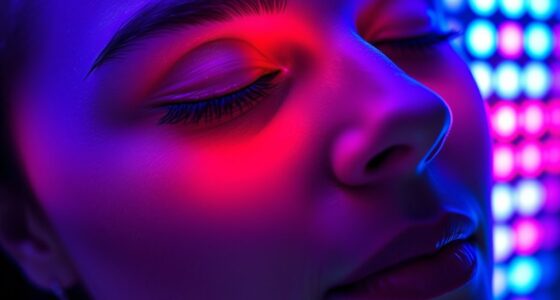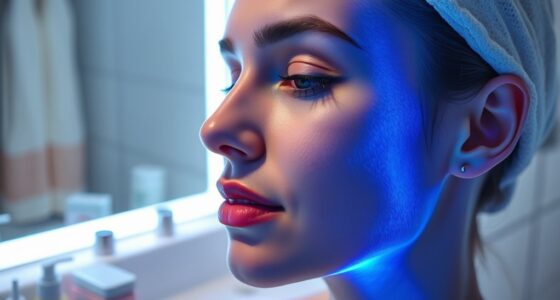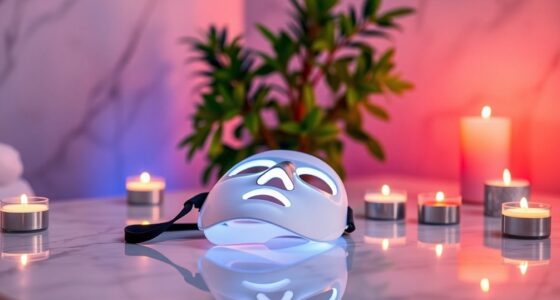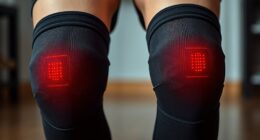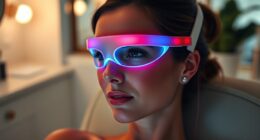To avoid irritation when combining LED therapy with retinoids, space out treatments by applying retinoids at night and scheduling LED sessions on non-retinoid nights or at least 24 hours after retinoid use. Start slowly with lower retinoid concentrations and increase gradually, always keeping your skin well-hydrated. Pay attention to your skin’s response, and if you notice redness or peeling, adjust your routine accordingly. Keep exploring for more tips on achieving safe, effective skincare.
Key Takeaways
- Schedule LED sessions at least 24 hours after applying retinoids to minimize irritation.
- Use gentle, hydrating moisturizers after retinoids and before LED therapy to buffer dryness.
- Start with lower retinoid concentrations and gradually increase to build skin tolerance.
- Perform LED treatments on nights without retinoids or on days when retinoids are not used.
- Monitor your skin’s response and adjust routines to avoid redness, peeling, or discomfort.
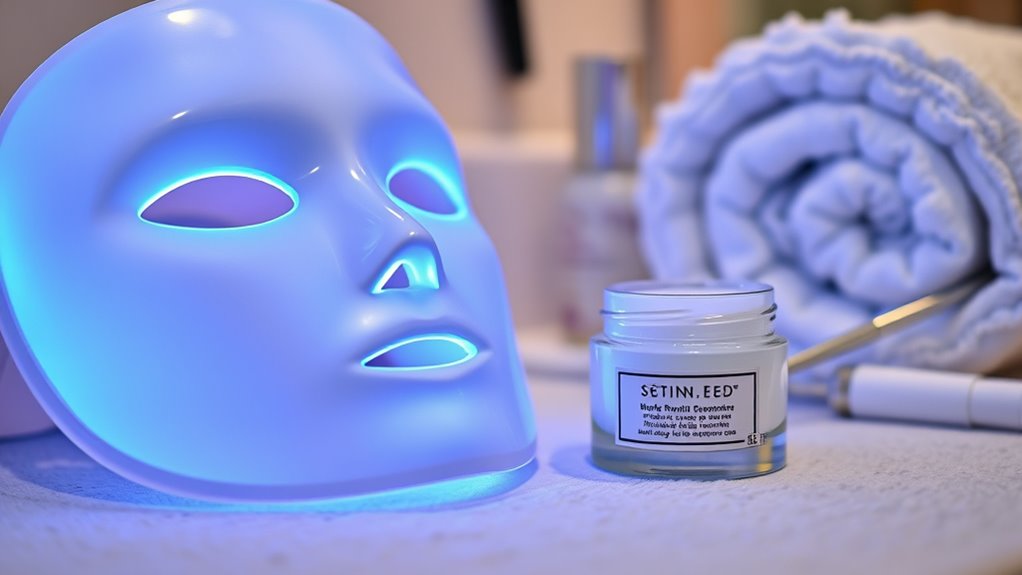
Have you ever wondered how combining LED therapy with retinoids can boost your skincare results? If you’re exploring these treatments, it’s essential to understand how they interact and how to prevent irritation. Retinoids are powerful ingredients that accelerate cell turnover, unclog pores, and improve skin texture. However, they can also cause dryness, redness, and peeling, especially when your skin is sensitive or new to retinoids. LED therapy, on the other hand, uses specific wavelengths of light to stimulate collagen, reduce inflammation, and promote healing. When used together, they can enhance your skin’s overall appearance, but without proper precautions, irritation can become a concern.
Combining LED therapy with retinoids can boost results but requires caution to prevent irritation and sensitivity.
First, it’s crucial to introduce retinoids gradually into your routine. If you’re new to retinoids, start with a lower concentration or apply them every other night. This allows your skin to build tolerance over time. When you combine this with LED treatments, which also can be intense depending on the wavelength and session duration, you want to avoid overloading your skin. Using retinoids too frequently alongside LED sessions can amplify dryness and redness, making your skin uncomfortable or inflamed. Hence, give your skin ample time to adapt, and don’t rush into daily treatments for both.
Timing is key to avoiding irritation. Many skincare experts recommend applying retinoids at night, as they can increase photosensitivity. Meanwhile, LED therapy can be performed during the day or after cleansing in the evening. To minimize irritation, consider scheduling your LED sessions on nights when you’re not using retinoids. Alternatively, if you want to combine them on the same day, wait at least 24 hours after applying retinoids before doing LED therapy. This helps prevent excessive skin sensitivity and reduces the risk of burning or peeling.
Moisturization plays a vital role in protecting your skin. Use a gentle, hydrating moisturizer after applying retinoids and before LED treatments. This creates a barrier that can buffer some of the dryness or redness caused by retinoids. Avoid harsh or abrasive skincare products that can exacerbate irritation, and steer clear of physical exfoliants when your skin feels sensitive. Always listen to your skin and adjust your routine accordingly—if you notice increased redness or peeling, give your skin a break and focus on hydration and soothing ingredients like aloe or ceramides.
In the end, combining LED therapy with retinoids can be highly effective, but it requires patience and attentiveness. By starting slow, timing treatments carefully, and prioritizing hydration, you can enjoy the benefits without suffering from unnecessary irritation. Your skin will thank you for taking these steps, and you’ll be able to see clearer, smoother results over time.
Frequently Asked Questions
Can I Use LED Therapy and Retinoids on Sensitive Skin?
Yes, you can use LED therapy and retinoids on sensitive skin, but you should proceed with caution. Start by consulting a dermatologist to confirm it’s appropriate for your skin type. Use gentle, lower-strength retinoids and gradually introduce them. For LED therapy, choose settings designed for sensitive skin, and avoid overuse. Always patch-test products first, and monitor your skin’s reaction to prevent irritation.
How Often Should I Apply Retinoids When Using LED Treatments?
Think of your skin as a delicate garden that needs gentle care. You should apply retinoids 2-3 times a week when using LED treatments, especially if you have sensitive skin. Start slowly and observe how your skin reacts, increasing frequency gradually. This cautious approach helps prevent irritation, allowing your skin to blossom beautifully without distress. Remember, patience is the key to glowing, healthy skin.
Are There Specific LED Settings for Retinoid Users?
Yes, there are specific LED settings recommended for retinoid users. You should opt for gentle, lower-intensity settings, such as red or near-infrared light, which help reduce irritation and support skin recovery. Always start with shorter sessions and gradually increase exposure as your skin gets used to both treatments. Consult your dermatologist or skincare professional for personalized advice, ensuring your LED therapy complements your retinoid routine safely.
Can Retinoids Cause Photosensitivity During LED Therapy?
Yes, retinoids can increase your skin’s photosensitivity during LED therapy. This means your skin might react more strongly to light exposure, potentially causing irritation or redness. To minimize risks, you should consult your dermatologist before combining retinoids with LED treatments. It is crucial to use a broad-spectrum sunscreen daily, especially during LED therapy, and to follow your healthcare provider’s recommendations to protect your skin effectively.
What Ingredients Should I Avoid Combining With Retinoids and LED?
Oh sure, just toss every potent ingredient into the mix—what could go wrong? You should avoid combining retinoids with harsh acids like glycolic or salicylic acid, vitamin C, or exfoliating scrubs. These can cause irritation or strip your skin’s barrier. Stick to gentle cleansers and moisturizers, and give your skin a break from irritating combos. Basically, treat your skin like royalty, not a science experiment gone wrong.
Conclusion
Think of combining LED therapy with retinoids like tending a delicate garden—you need patience and gentle care. When you follow the right steps, you’ll nurture your skin without stripping it of its liveliness. Avoid irritation by starting slowly, listening to your skin’s signals, and always using soothing products alongside. With consistent, mindful effort, you’ll see your skin blossom into a healthier, more radiant version of itself—like a garden in full bloom.


